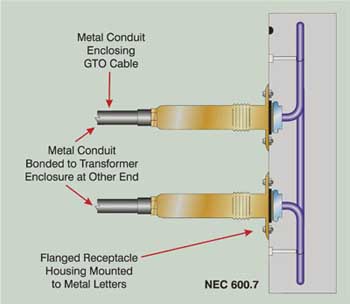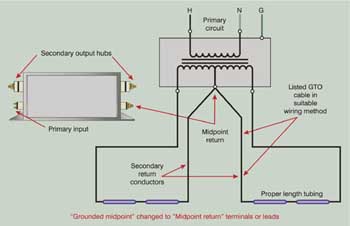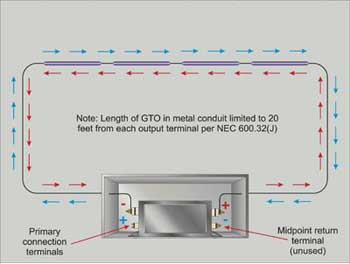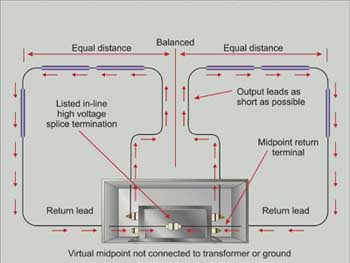There have been many changes in the world of neon installations during the beginning of this millennium. These changes involve the requirements in 600.32 of the National Electrical Code. This section was created with the hopes of mechanically preventing many electrical fires that had been appearing for years. The issues and problems that have ensued are not because this is a bad section or the products in the field are flawed, but rather because of extenuating circumstances in the field.
First, many authorities having jurisdiction are challenged with the responsibilities of properly applying the appropriate rules in Article 600. Familiarity with neon signs and systems and the proper application of the rules thereto are essential for protection of persons and property.
Second, many sign personnel in the field have insufficient training in electrical trade fundamentals.
Secondary-Circuit Ground-Fault Protected Transformers and Problems They Create
A new breed of transformer has arrived on the scene. These transformers, unlike their predecessors, are designed with trip sensors on the secondary side of the transformer to detect the line-to-ground anomalies (ground faults). Line-to-line issues (short circuits) are not mechanically policed.

Figure 1. Flanged receptacle housings
Because of their lack of knowledge of basic grounding (earthing), grounded conductors, and bonding principles, many sign/neon installers are finding it hard to keep neon displays illuminated for long periods of time. The gremlin in the wax is called nuisance tripping. In many jurisdictions where inspections of neon displays are not as thorough or not performed at all, transformers that are non-compliant to 600.23 are often being utilized. This non-conforming remedy eliminates nuisance tripping.
What about jurisdictions that are fairly stringent in regard to Article 600 and its neon segment? Many sign companies have a display inspected with the compliant power supplies, and after the inspection is signed off by the local jurisdiction, the compliant power supplies are swapped out for the older non-compliant models. This is similar to the escapades that went on when the ground-fault circuit interrupters became a requirement in the early 70s. Is it right? No, however this is happening daily all across North America. Hopefully as installers work through the challenges and become more familiar with the SCGFP units and their associated wiring, the data will support a definite reduction in property losses. This would be similar to the data that supports the fact that GFCIs are people protectors and are saving lives.
The newly surfacing consequence of this breed of transformers is economic hurt to the neon industry at the grass roots level. Many small and mid-size sign companies are going out of business due to the inability to light contracted displays. Perfectly good transformers are being returned to distributors under the illusion that these units are bad. It is sad to watch transformer manufacturers being hit with product chargebacks on perfectly good units. Yet, what is the solution?
Education and Help

Figure 2.
The above issues have been presented for the purpose of requesting help and understanding from both the inspection and electric sign community. This help begins with education, and in many jurisdictions grass roots inspectors can increase that education.
On the other side, the largest sign publication in the world, Signs of the Times, is about to introduce a course on electrical basics to educate grass roots electrical sign installers and inspectors. This course of action seems to be the best approach to solving this situation.
Therefore, one must understand some of the issues confronting electrical sign professionals.
Grounding, Grounded, Bonding
The vast majority of electrical sign installers do not understand the basics of grounding, grounded, and bonding. This lack of understanding is why many of the transformers are failing in the field. After all, these are secondary-circuit ground-fault trannies. If we truly want to help, we must develop an understanding of where the problem points are regarding electrical signs and neon systems.

Figure 3. Since the beginning of neon time, the wiring method employed and learned by every apprentice entering the electric sign field was called the “standard series wiring method”
In reality, an electric sign person really doesn’t have to know about concrete-encased grounding electrodes, often called a “Ufer ground,” or that Ufer was an engineer from UL that developed the concrete-encased electrode in Arizona in the early 1940s. What can be a help to everyone is sharing some of the solid principles from the new Soares Book on Grounding. The new electric sign section begins on page 274 and continues to the end of Chapter 16. Of interest to almost every installer would be the flanged receptacle housings found in figure 16-35. True, most sign people have never seen these housings, yet they are supplied by two major sign manufacturers. These housings are about the cleanest way to achieve proper bonding with the dead metal of the letter returns. One will also be able to demonstrate that almost 100 percent of the time these dead metal returns are not grounded or bonded per the NEC. This issue alone can contribute to nuisance tripping. The information on sign grounding included in the eight pages on electric signs in the new Soares book can be a great help for inspectors and installers alike.
Capacitance
The second reason these newer transformers are failing in the field is due to capacitance. Capacitance has been creating great destruction in the field of luminous tubing for a long time. However, the new generation of compliant transformers with fault sensing devices are tripping at an alarming rate due to this property. What is happening is that the high voltage conductors are trying to couple with any metal when extremely long high voltage metallic runs are energized. Per the NEC, twenty feet is the maximum length an energized conductor is allowed to run when it comes off the output hubs to its first electrodes. The problem is that twenty feet of HV cable is much too long for all practical purposes, especially, in the case of red fill (neon) tubing. For this reason, we must develop an understanding of the concept of mid-point wiring methods and techniques within the inspection and sign communities. A good schematic of this principle can be found in Soares Grounding and Bonding, page 277 in figure 16-33.

Figure 4. While this method has a place in our discipline, the wiring method of this millennium has to become the “virtual mid-point wiring method”
The reason for mid-point wiring is to reduce the length of output (secondary) runs from both hubs to their shortest denominator. In photo 1, the output runs, while not violating the NEC or any listing agency standard in reference to the 20-foot length, can create excessive capacitance that not only can cause the high voltage cable to burn up at each connector entering the transformer box but also can couple to every metal part within that box, including the box’s base. Nineteen to twenty-foot runs, while compliant, are more than these or most systems can tolerate. One solution to this conundrum is shown in figure 2, where secondary runs can be reduced from 20′ to 8″ with the rerouting of the output conductor through the top of the transformer enclosure. Meanwhile, the mid-point returns are returning back to the box in the original wiring method. Where flexible metallic conduit, is used, it may be installed in total accumulative lengths of up to 100′ for bonding purposes. The return lengths for those conductors, while not being grounds in nature, are still at or near ground potential.
What must happen, and many experts agree, is that the sign profession has to adopt a new basic wiring method. Since the beginning of neon time, the wiring method employed and learned by every apprentice entering the electric sign field was called the “standard series wiring method” (see figure 3). While this method has a place in our discipline, the wiring method of this millennium has to become the “virtual mid-point wiring method” (see figure 4). Only the virtual mid-point method can address the ringing (resonance) problems that our metal-encased high voltage neon/argon systems have created. What has happened is the metal enclosures (raceways) for the HV system secondary are actually turning each of the output conductors into capacitors. The capacitance on a 19′ or 20′ run to neon components and power supplies is very radical in comparison to two 6″ or 8″ lengths that connect to the first electrode.
To this date, the biggest application problem affecting our industry is in dealing with exposed skeletal neon and border tubing (see IAEI News January/February 2000, pg. 31–34). For the most part, these types of applications usually stray far from the Code and require an astute grasp of neon and electrical know-how regarding installation and inspection. Once as a friend of mine stated, “Only God can grant special permission; everything else must be listed.” Signs and outline lighting systems are required to be listed per 600.3 with the exception of field installed skeleton tubing, which falls under the requirements of Part II of Article 600.
In Hickory, North Carolina, signage/neon issues are taken very seriously, to the point that it became mandatory that every piece of outline lighting or border tubing either came in listed sections or an NRTL was called in to perform a field evaluation. These principles provide a great deal of safety to the community while outlying municipalities seem to have difficulty providing any type of safety margin. This neon genie does not require a large infrastructure to control.
The last example of addressing this problem occurred in the town of Boone, North Carolina. In that beautiful mountain town, one person started enforcing the “”everything listed principal”” and treated Article 600 as a section worth merit. Then, to this small town’s credit, some of the nicest, safest, listed, border tubing displays ever seen started arriving. The AHJ was not out to hang anyone but imparted his knowledge to the various sign companies that entered his jurisdiction.
This article has been passed for review before publishing to various state and provincial electrical inspectors, manufacturers, electrical safety associations, and corporate and industrial safety officers. Special thanks to: Les Beros, Code Enforcement SaskPower (Regina, Saskatchewan, Canada); Telford Dorr, Microtron (Encinitas, CA); Jeff Hinkle, City of Hickory Code Enforcement (Hickory, NC); Gary Nutting, Neon Products of Phoenix (Phoenix, AZ); Mike Pennington, Code Enforcement, (Indianapolis, IN); Wade Swormstedt, Signs of the Times magazine, (Cincinnati, OH); Marcus Thielen, neon consultant/columnist (Duisburg, Germany), and Eddie Wieber, Sign Business magazine (Broomfield, CO).










Find Us on Socials